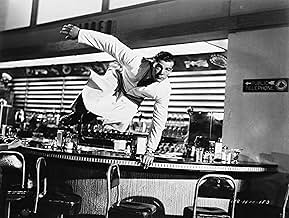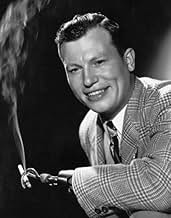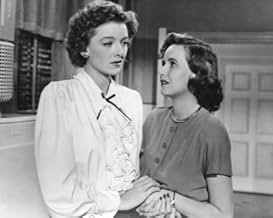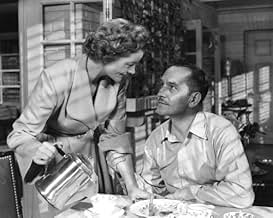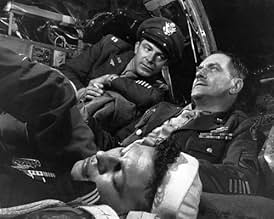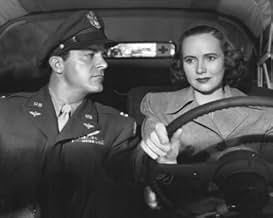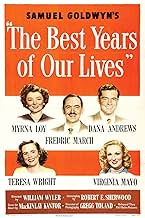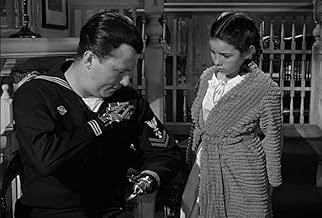Tres hombres que regresan de la guerra a su ciudad realizan juntos la etapa final del viaje y entablan amistad. Cada uno se encuentra, a su manera, con dificultades para adaptarse de nuevo a... Leer todoTres hombres que regresan de la guerra a su ciudad realizan juntos la etapa final del viaje y entablan amistad. Cada uno se encuentra, a su manera, con dificultades para adaptarse de nuevo a una vida normal.Tres hombres que regresan de la guerra a su ciudad realizan juntos la etapa final del viaje y entablan amistad. Cada uno se encuentra, a su manera, con dificultades para adaptarse de nuevo a una vida normal.
- Dirección
- Guionistas
- Elenco
- Ganó 7 premios Óscar
- 25 premios ganados y 4 nominaciones en total
- Al Stephenson
- (as Frederic March)
- Dirección
- Guionistas
- Todo el elenco y el equipo
- Producción, taquilla y más en IMDbPro
Resumen
Opiniones destacadas
Crafted with care, narrated with flair & incessantly human in its approach, William Wyler's film's silent, thoughtful contemplation on PTSD is still as relevant today as it was at its time of release. Firmly grounded in realism & having stood the test of time all these years, The Best Years of Our Lives is one of the finest offerings of its kind.
Definitely a family orientated movie (Cert U) this will appeal to and find favour with all ages, but don't start thinking that this is all gooey, slushy nonsense. There's some quite hard-hitting topics covered, even by today's standards and of course, with our minds on our current troops in Iraq/Afghanistan, equally relevant.
Multi-stranded, which each of the three G.I.'s immediate and extended families and friends being examined, it's about them coping, with varying degrees of success, with home life and getting jobs, now that the War is ended. It's the little observations and stories around them that are so fascinating, as the Heroes of yesterday are now anything but when it comes finding new purpose in a changed world.
The cast is exemplary, not necessarily the biggest stars of the day but the most believable and natural for their roles. Dana Andrews, Myrna Loy and Fredric Marsh are the ones most easily recognisable and their appearances convey a sort of reassuring familiarity and normality. They're all excellent, of course.
Though long, at nearly 3 hours, William Wyler's easy going but assured and tight direction keeps things flowing nicely and it never drags. This, my second viewing, is an enjoyable one as the first and if anything I'm more at ease with it.
Though obviously not as exciting or dramatic as other 'normal' war films, it's a tragedy that it's not more well known. I've never seen it to ever have been on TV, or to my recollection, even Sky Movies, for that matter. Any movie that won 7 Oscars and is currently no. 180 in the top 250 IMDb's films of all time, voted by its voters (us, the public) is hardly one of minority interest.
A friend I lent my DVD to watched it with his family and normally they only go for current films, or ones they know, but they not only enjoyed it, but felt enormously moved by it, too.
If you haven't seen The Best Years... yet, make a mental note to do so. Your life won't change by doing so, but it really is worth the 3 hours of it that it will take. You certainly can't say the same about every film out there....
And while we don't often learn from history, we can be thankful that for once the United States of America did learn from what happened with its veterans after the previous World War. The GI Bill of Rights is mentioned in passing in The Best Years of Our Lives was possibly the greatest piece of social legislation from the last century. So many veterans did take advantage of it as do the veterans like Fredric March, Dana Andrews, and Harold Russell who you see here.
All three of those actors played archetypal veterans, characters that every corner of the USA could identify with. They all meet on an army transport plane flying to the home town of all of them, Boone City, Iowa.
War is a great leveler of class and distinction. Bank employee March, soda jerk Andrews, and high school football star Russell probably would never meet in real life even in a small town like Boone City. But they do meet and war forges indestructible bonds that can never be broken.
March is the oldest, a man with two children and Hollywood's perfect wife Myrna Loy. He settles in the first and the best. He has some wonderful scenes, getting cockeyed drunk on his return and later with a little bit of liquor in him, tells the bank officials at a banquet off in no uncertain terms.
I also love his scene where another returning veteran, a sharecropper wants to get a bank loan for his own piece of land. Watch March's expressions as he listens to the man's pitch for money. You can feel him read the man's soul. It's what got him his Second Best Actor Oscar for this film.
Harold Russell was a real veteran who lost both his hands during service in the Pacific. He got a special recognition Oscar for his performance. Because of that it was probably unfair to nominate him in the Supporting Actor category which he also won in. His performance, especially his scenes with Cathy O'Donnell as his sweetheart who loves him with or without his hands, is beyond anything that could be described as acting.
Dana Andrews is the only officer of the three, a bombardier in the Army Air Corps. Of the group of them, maybe he should have stayed in. He also comes from the poorest background of the group and he was an officer and a gentleman in that uniform. That uniform and those monthly allotment checks are what got Virginia Mayo interested enough to marry him. The problem is that he's considerably less in her eyes as a civilian.
While Mayo is fooling around with Steve Cochran, Andrews has the great good fortune to have March's daughter Teresa Wright take an interest in him. They're the main story of the film, Andrews adjustment to civilian life and adjusting to the fact he married the wrong woman. Not all veteran's problems were solved with GI Bill.
Myrna Loy gets little recognition for The Best Years of Our Lives. My guess is that it's because her role as wife was too much like the stereotypical wife roles she had patented over at MGM. Still as wife to March and mother to Wright she really is the glue that holds that family together.
The Best Years of Our Lives won for Best Picture for Sam Goldwyn, Best Director for William Wyler and a few others besides the two acting Oscars it got. It was a critical and popular success, possibly the best film Sam Goldwyn ever produced. It remains to this day an endearing and enduring classic and will be so for centuries. It's almost three hours in length, but never once will your interest wane.
The best tribute this film received came from Frank Capra who had a film of his own in the Oscar sweepstakes that year in several categories. In his memoirs he said that he was disappointed to be skunked at the Oscars that year, but that his friend and colleague William Wyler had created such a masterpiece he deserved every award he could get for it.
By the way, the film Capra had hopes for was It's A Wonderful Life. The Beat Years of Our Lives can't get better praise than that.
The whole point of this film when it was released still makes perfect sense today, though I'm sure it doesn't have the same impact it did in those first years after World War II ended. Returning servicemen, with all kinds of backgrounds before and during the war, hit a wall coming home: wives who no longer loved them, jobs that had dried up, a culture that was foreign to them and that found them, these men, to be foreign themselves.
It wasn't a crisis to take lightly. These were the guys who were drafted to fight the enemy, and in going overseas they lost some of the best years of their lives, if not their lives. The country knew its debt in the abstract, but it also knew it in sons and husbands who really did come home and who had to face it all. This movie was both a reckoning for the sake of national healing and a brilliant drama that would be beautifully pertinent and therefore successful. And what a success, then and now.
The consummate Hollywood director William Wyler shows in this fast, long movie just what a master he is at working the medium. With Gregg Toland at the camera, Wyler makes a highly fluid movie, visual and dramatic and weirdly highly efficient. With the three main plots interweaving and depending on each other, the drama (and melodrama) build but never beyond plausibility. Wyler knew his audience wouldn't put up with pandering or cheap mistakes. Casting Harold Russell as Homer, knowing the audience would hear about how Russell really was a soldier who lost both hands in the war, was a huge step toward creating both empathy and credibility. It even practices a key theme in the move--to go beyond your bounds to make a difference, to give these guys a break and help them assimilate.
It's interesting how singular this movie is, trying to show the truth in these kinds of situations. The other post-war films about army and navy men fall into two large and dominating categories--war films and film noir. And it is film noir that comes closest to getting at the problem of the G.I. not reintegrating well, making it a whole style, brooding and spilling over with violence. "The Best Years of Our Lives" has a highly controlled and even contrived plot structure, but it aims to be honest and representative.
That it's remarkable formally--the way it is shot and edited and acted, top to bottom--is not surprise, given the heights that Hollywood had reached by then, and given that Wyler is easily the slickest of them all, in the best sense. That the movie makes such beautiful sense and really works as a story, a moving and heartwarming story without undue sappiness, is a whole other kind of achievement. A terrific, rich, full-blooded, uncompromised movie.
Oscars Best Picture Winners, Ranked
Oscars Best Picture Winners, Ranked
¿Sabías que…?
- TriviaFor his performance as Homer Parrish, Harold Russell became the only actor to win two Academy Awards for the same role. The Academy Board of Governors thought he was a long shot to win, so they gave him an honorary award "for bringing hope and courage to his fellow veterans through his appearance." Later in the ceremony, he won for Best Supporting Actor.
- ErroresWhen Al introduces his wife and daughter to Fred and Homer at Butch's, he refers to Dana Andrews as Homer and Harold Russell as Fred. This was intended as a consequence of Al being drunk.
- Citas
[after Peggy tells her parents that they never had any trouble in their relationship]
Milly Stephenson: "We never had any trouble." How many times have I told you I hated you and believed it in my heart? How many times have you said you were sick and tired of me; that we were all washed up? How many times have we had to fall in love all over again?
- Créditos curiososThe character played by Ray Teal (the Axis sympathizer whom Homer Parrish attacks at the soda fountain) is listed in the credits as "Mr. Mollett". However, the character's name is never mentioned or otherwise alluded to.
- Versiones alternativasThe film was modified to play on a wide screen and reissued on February 3, 1954.
- ConexionesEdited into Titán del espacio (1950)
- Bandas sonorasAmong My Souvenirs
(1927) (uncredited)
Music by Edgar Leslie
Lyrics by Lawrence Wright
Played on piano by Hoagy Carmichael
Selecciones populares
Detalles
- Fecha de lanzamiento
- País de origen
- Idioma
- También se conoce como
- The Best Years of Our Lives
- Locaciones de filmación
- Productora
- Ver más créditos de la compañía en IMDbPro
Taquilla
- Presupuesto
- USD 2,100,000 (estimado)
- Total en EE. UU. y Canadá
- USD 23,650,000
- Total a nivel mundial
- USD 23,667,133
- Tiempo de ejecución2 horas 50 minutos
- Color
- Relación de aspecto
- 1.37 : 1
Contribuir a esta página



